LG V60 5G ThinQ review: A compromised phone I like anyway
It still needs polish, but you get a lot of phone for the price.
When LG first showed us its new V60 ThinQ, I was immediately over it. Its redesign was nothing radical. It lost the V-series’ hallmark telephoto camera. It featured software that, despite years of attention, still felt poorly thought out. And, perhaps worst of all, its hallmark feature — a clip-on second display — can still be tricky to use because of some strange interface decisions. In other words, I thought I’d be in for an easy review: “Another half-baked effort from LG, please try harder next time, insert score here.”
And then I started living with it.
To be clear, it’s not like any of the issues I mentioned stopped annoying me; LG should still address them, and soon. A company this big, with no shortage of technical talent, can do better. Eventually, though, that initial frustration faded, and the stuff the V60 got right started mattering more. It's not a perfect phone, but it is a pretty good deal.
Key specs
| LG V60 ThinQ |
|---|---|
Processor | Octa-core Snapdragon 865 |
RAM / storage | 8GB/128GB |
MicroSD card support | Yes, up to 2TB additional |
Main Display | 6.8-inch P-OLED FullVision |
Display resolution | 1,080x2,460 (20.5:9) |
Rear cameras | 64MP f/1.8 standard wide camera with dual-pixel PDAF and OIS, 13MP f/1.9 ultra-wide camera (117° field of view), “Z Camera” time-of-flight sensor |
Front-facing camera | 10MP f/2.9 camera |
OS | Android 10 with LG UX 9 |
Battery | 5,000mAh |
Charging | USB-C, supports QuickCharge 4.0 and wireless charging |
Dimensions | 169.3 x 77.6 x 8.9 mm |
Weight | 216g |
Fingerprint sensor | Yes, in display |
Waterproofing | IP68 |
NFC | Yes |
Headphone jack | Yes |
Configurations
The LG V60 ThinQ is available in blue and white, but you’re stuck with the same base 8GB of RAM and 128GB of storage no matter which color you choose. The phone is available through AT&T, Best Buy, T-Mobile and Verizon, which is only really notable because of the differences in price and freebies available:
AT&T: $900 with a free dual-screen case
Best Buy (AT&T only): $900 with a $50 Best Buy gift card
Verizon: $900 with a free dual-screen case
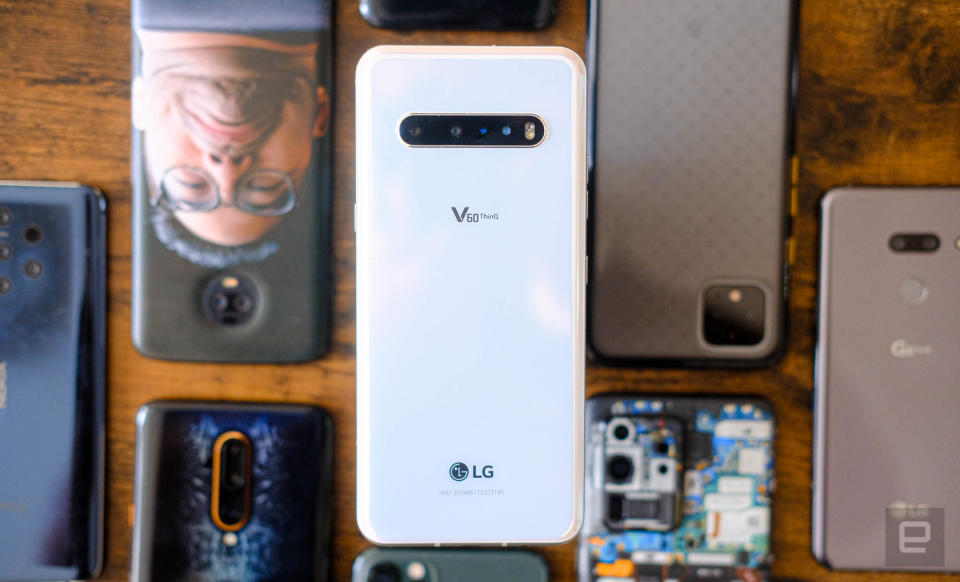
Back to basics
LG's design philosophy hasn't changed much over the last few years: Make screens bigger, shrink the bezels, round the corners and throw in some more cameras. Some of those traditions hold in this year's V60, but the company also backtracked in some unexpected ways.
For one, the V60 is a touch boxier and more angular than the models that came before. It feels more substantial than phones like the G8X ever did, and I dig the contrast between the chamfered metal frame and the slightly rounded glass back. Let's be honest, though: The V60’s design isn't going to work for everyone. To start, it's much bigger than the phone it replaces, which spells trouble for anyone with smaller hands. It already feels a little dated too. With its row of rear cameras framed in black and its largely unadorned back, the V60 is a dead ringer for one of last year's flagship Samsung phones. Admittedly, there's nothing wrong with adopting a very familiar design -- it just feels a little lazy. Earlier V-series phones managed to carve out their own visual niche, so why couldn't this one?
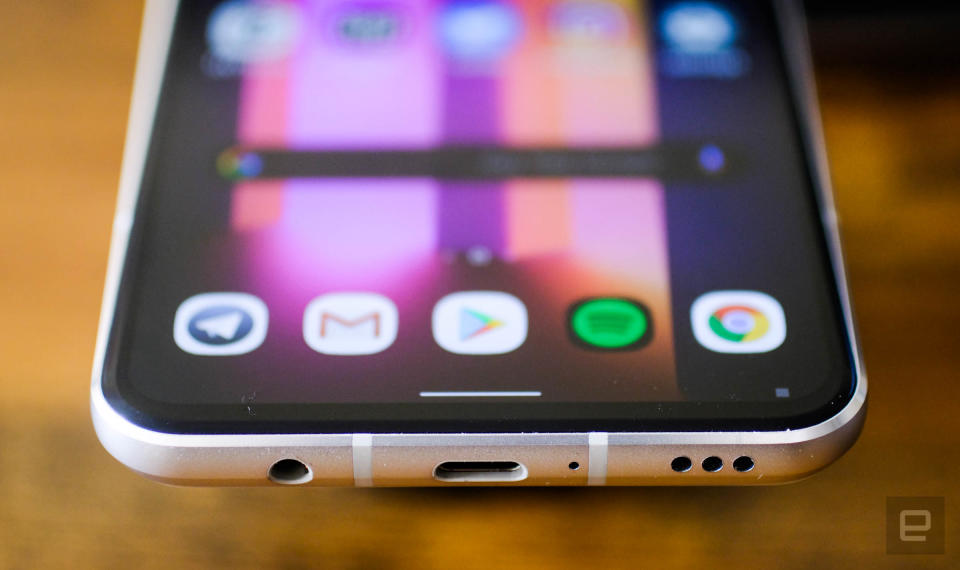
In fairness, there are still plenty of distinctly-LG touches here, like a dedicated Google Assistant key under the V60's volume buttons, and a proper headphone jack next to the USB-C port. If you need proof that LG isn't playing the same flagship game as everyone else, though, just take a good look at the V60's face.
The 6.8-inch P-OLED screen is the biggest display LG has ever squeezed into a phone, and frankly, it's gorgeous. Colors look sumptuous and you won't have trouble seeing any action while peering at it from an angle. In fact, this screen is pretty enough to make you forget how basic it is. Unlike many newer phones, the V60's screen still refreshes at the standard 60Hz. Beyond that, the screen only runs at Full HD+. When you factor in the panel's oddball, 20.5:9 aspect ratio, that works out to a resolution of 2,460x1,080. (For reference, last year's V50 had a 6.4-inch screen that ran at 3,120x1,440.) These alone might be enough to make some people write off the V60, and the chunky bezels certainly don't help. If you haven't clicked away in disgust yet, hear me out: They really aren’t that bad.
Yes, super-crisp 2K screens are great, and no, they're not going anywhere soon. Neither are high-speed displays, like the one Samsung's Galaxy S20 uses. So why does the V60 get a pass? Well, while the industry has started to change, our eyes haven't. 1080p (or the extended equivalent used here) is still perfectly fine for day-to-day use, and you won't notice much of a difference between this screen and a more pixel-dense one until your eyes are millimeters away.
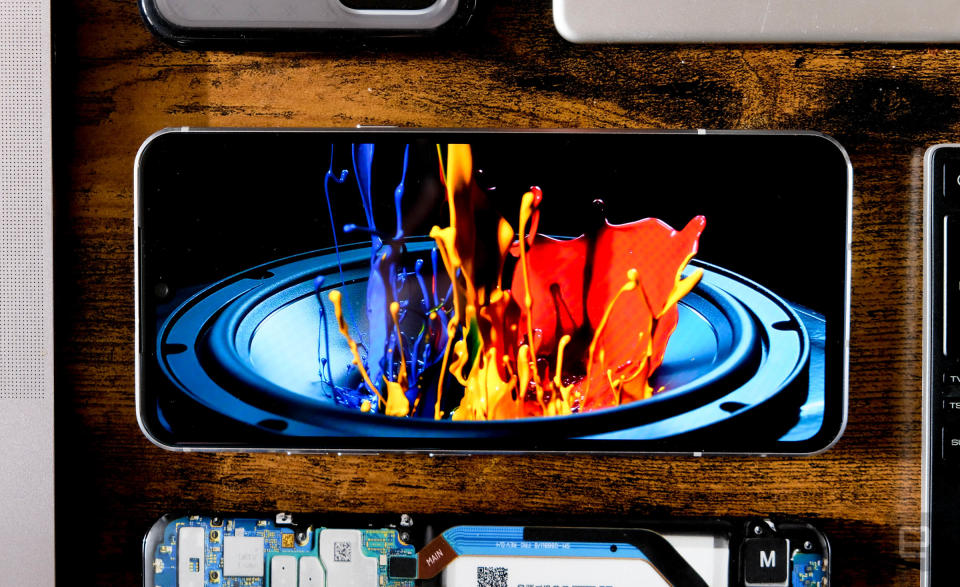
Most important, skipping a sharper screen means the V60 doesn't cost nearly as much as a big, Samsung flagship, and I think we can all get behind that. Oh, and the bezels? Tell me if this sounds familiar: You pick up your phone and whoops! Your palm grazed the screen because it's curved and stretches from edge to edge, and now you've wound up some app or menu you never meant to visit. The V60's flat, bezel-framed screen might not be as pretty as others, but it means those obnoxious misfires rarely happen.
There are a few other features worth pointing out here: The V60 is, for instance, rated IP68 for water and dust resistance, so it'll survive a drop in the shallow end of the pool. There's a microSD card slot, so you can supplement the 128GB of onboard storage with up to an extra terabyte. As with earlier models, the V60 packs a Quad DAC for fantastic audio quality when using wired headphones; there is no phone better suited for audio nuts. And rather than stick with the discrete fingerprint on its back, LG instead gave the V60 an in-display sensor that works with remarkably little fuss. (I certainly can't say the same about the Galaxy S20.)
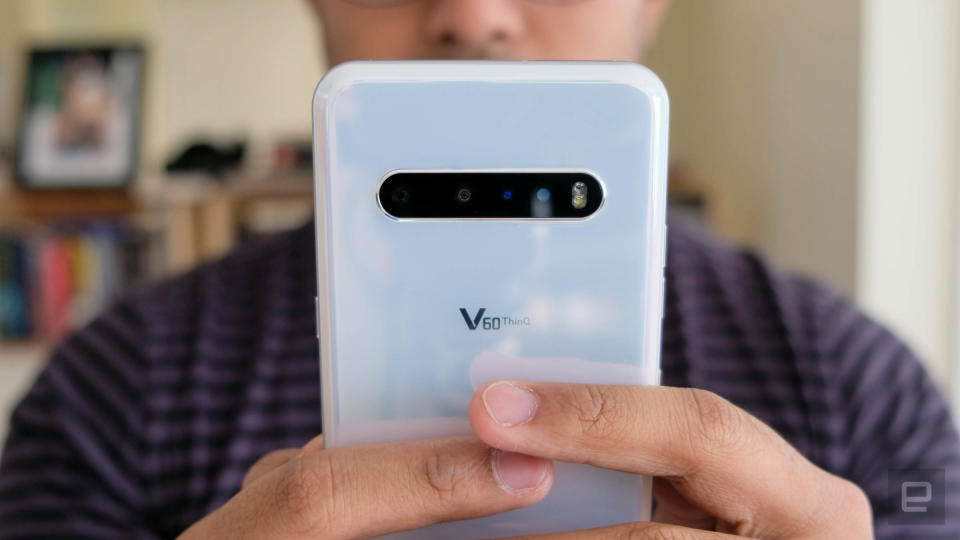
In use
By now, it's clear that LG made some compromises to drive down the V60's price. It should also be clear that many of those compromises are relatively easy to live with. Consider the chipset: Like every other flagship Android phone you'll see this year, the V60 uses Qualcomm's top-of-the-line Snapdragon 865, so you can expect consistently quick performance in line with devices that cost hundreds of dollars more. That's the good news. The bad news is that the V60 has 8GB of RAM, instead of the 12GB that's more or less standard across this year's flagships. I'll admit it: I was concerned at first that I'd see some differences in multitasking performance between the V60 and a device like the Galaxy S20, but nothing leapt out at me.
Don't get me wrong: Having more RAM is always a good thing, and since the V60 is working with a slight deficit, it's not quite as future-proof as other phones. Apps aren't going to get any less complicated or demanding, after all. Still, I don't think most people mulling a smartphone purchase should turn up their noses at what mostly feels like speedy, stable performance.

The cameras aren't bad either, even if there are fewer of them than usual. A 10-megapixel front camera is wedged into a small, semi-circular notch that cuts into the screen, while a 13-megapixel rear ultra-wide camera sits next to a 64-megapixel wide sensor around back. All three take serviceable photos, though you should stick with that standard wide camera whenever possible -- its colors are livelier, and it does a better job exposing the scene in front of you. I should point out the main camera sometimes struggles to focus on objects sitting in front of it, but it's nothing compared to how bad the S20s were at locking on when they launched.
Oh, and there's one more sensor we haven't talked about yet. LG calls it a Z camera, but "camera" isn't exactly the right word. It's actually a time-of-flight sensor that gathers depth and distance data. Apparently, that was more important than a telephoto sensor, something that's been a V-series mainstay for the last two years. Instead, you'll have to do all your zooming with that 64-megapixel sensor, which doesn't work nearly as well as the company suggests. Zooming in to 2x yields usable results. But, LG claims you should be able to push in up to 10x without a significant reduction in quality, and that's just not true. The camera does its best to turn the resulting photos into something usable, but this is pure digital zoom we're talking about here -- don't bother searching for fine details.
You can also use that Z camera to whip up "3D portraits," inspired by those pseudo-3D animated photos you've probably seen in your Facebook feed. It's a fun idea in theory, but one that mostly falls flat in practice. Yes, it's neat to tilt your phone around and see your subject and the background shift in response -- the problem is, you'll also see some noticeable blurred areas where the phone tries to fill in space that your subject was never physically filling in the first place. Expect to use this once and then forget about it entirely.
Thankfully, there are some valuable new camera features here to offset, well, whatever that thing was. The most notable: The V60 can capture 8K footage at 24FPS without skipping a beat. The handful of test clips I shot looked nice enough on the V60's screen but considering that display's relatively low resolution -- and the lack of widely accessible 8K monitors -- the whole thing felt a little underwhelming. Oh well. Being cooped up at home for the last two weeks means none of that footage was super interesting anyway.
But I can live with all that because the fundamentals are solid. The best example: battery life. Even with a speedy processor thrumming away, the V60's 5,000mAh battery easily lasts for a day and a half of fairly consistent use. And when your load lightens over the weekend, hitting a full two days between charges is totally doable. That's among the best we've seen from this year's crop of high-end phones, which is no small feat considering the toll 5G connectivity can have.
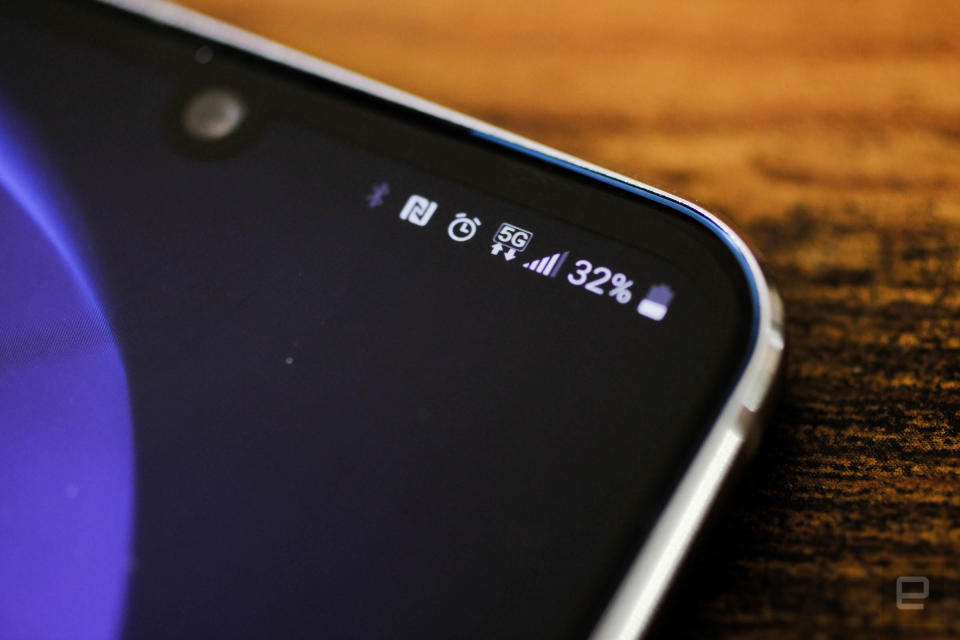
Speaking of 5G, the V60 might be the very first 5G device some people invest in. My advice: Keep your expectations in check. I've been testing a T-Mobile-branded V6,0 and as you might have already heard, the carrier's sub-6 5G network isn't that much faster than plain-Jane LTE. (Though, it does have a much bigger footprint than Verizon’s mmWave network.) Now that the merger is complete, Sprint's mid-band 5G sites will get rolled into T-Mobile's network over the coming months, so speeds should increase.
AT&T's version of the V60 also plays nice with sub-6 5G but isn't compatible with the new mmWave 5G+ service the carrier is slowly rolling out. And for what it's worth, Verizon (Engadget’s parent company) has a mmWave 5G network that can be much faster than AT&T's or T-Mobile's networks ... until you go inside or scoot out of range of a 5G node. Confused yet? Don't worry about it. No matter which carrier you've pledged allegiance to, 5G network performance will only get better from here.
I wish I could say the same about LG's software. To the company's credit, its updated LG UI doesn't feel as cumbersome as it used to, and it does a decent job at letting Android 10 shine where appropriate. As always, the problem is that LG doesn't seem to have completely thought through all the details.
You can't, for instance, remove this phone's battery. It's sealed. So why does the V60 occasionally remind me that I shouldn't take the battery out? Your guess is as good as mine, but I'm willing to bet LG just never bothered to change that notification. That's not a great look when the last premium LG phone with a removable battery was released four years ago. What else? Well, I like the apps in my app drawer sorted alphabetically, but they never stay sorted. Every time you download a new app, it goes to the end of the list, and every app you delete leaves an empty space in the app drawer behind. If you’re like me, that means you’ll have to smash the sort button way too often.
LG was also one of the first companies to embrace gesture controls for the notification shade. Back when its phones had rear fingerprint sensors, you could brush your finger against it to see all of the information that just rolled in. You'd think LG would turn that into a simple on-screen gesture like so many other smartphone makers already have, but nah. You still have to reach up to the top of the screen, which isn't always easy considering how big this thing is.
These are minor gripes, sure, but they're symptomatic of something more dire happening inside LG. The company's software hasn't felt polished in years. And, honestly, I’m not sure it ever did. What's it going to take for LG to take a look at what's happening and just decide to do better?
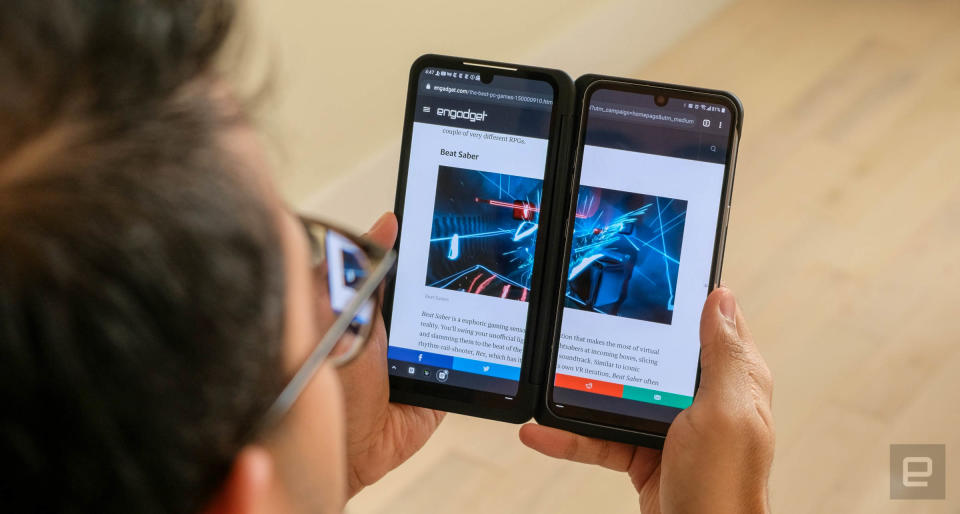
The dual-screen life
Now we're getting to the weird stuff. Just like it did with the G8X, LG built a case with a second screen that turns the V60 into an ersatz foldable, and there's a pretty good chance the company will just give you one for free. (As of this writing, Verizon and AT&T customers can claim these accessories gratis; T-Mobile has a sort of buy-one-get-one deal instead.)
A lot of this will sound familiar if you've read our G8X review, but let's quickly run through the basics. This case packs a 6.8-inch screen just like the V60's, and once attached, it mostly acts as a separate smartphone. Sure, both displays share software and a brain, but many of the apps you probably use regularly can't take advantage of both screens simultaneously. Instead, you're largely locked to one app per screen.
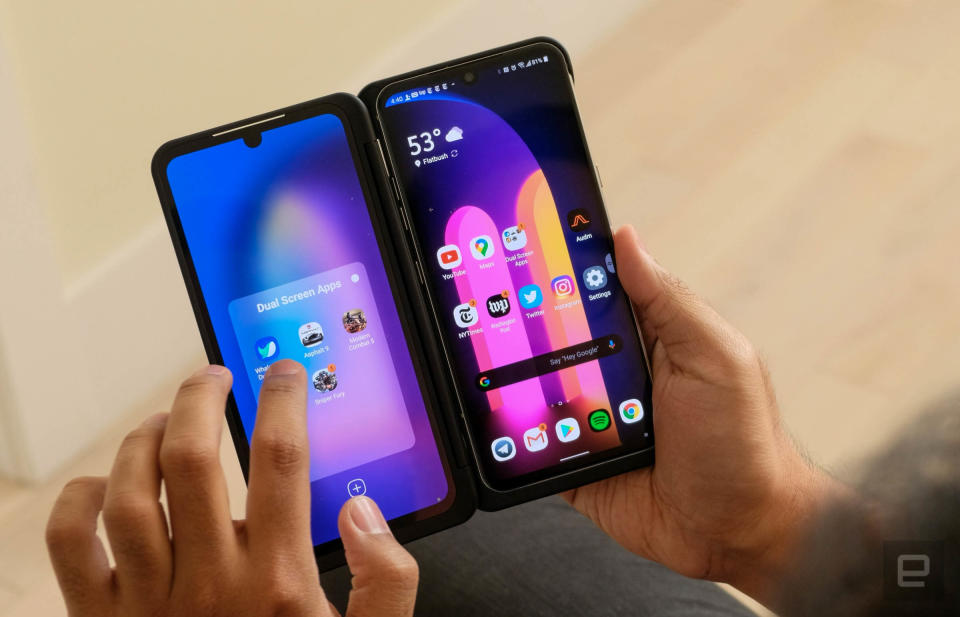
It's not hard to imagine scenarios where that could be helpful. You could watch Tiger King, for instance, and tweet about Carole Baskin at the same time. Or work on a New York Times crossword on one screen and look up the answers in Chrome on the other. (I have done this precisely once, and I'm not proud.) I haven't needed to run two separate, full-size apps side by side most of the time, but it's nice to know I can -- and for free, no less.
What's more interesting are the ways these two screens can work together. For one, LG expanded support for what it calls "wide view" mode, so now you can set a slew of Google apps (YouTube, Maps, Gmail, Photos, etc.) to stretch across both screens. None of these are enabled by default so setting things up takes a little extra work, but the result is that you can use the V60 and its second screen like a small, foldable tablet. Sort of. The problem is, there's still a big ol' hinge separating the two displays, so watching YouTube videos and thumbing through old photos isn’t exactly satisfying. Alright, fine: It looks dumb, but it's really hard to argue with free.
There are other ways to take advantage of these two screens in tandem, some of which work better than others. While using the camera, I could review photos I just shot on that secondary display, so I knew immediately if I needed to try again. If you're a furious texter (or in my case, someone with too many Telegram group chats), you can also use one of the screens as a big, dedicated keyboard. (The option is only available if you're using the stock LG keyboard, so be ready to switch if you're a Gboard person.)
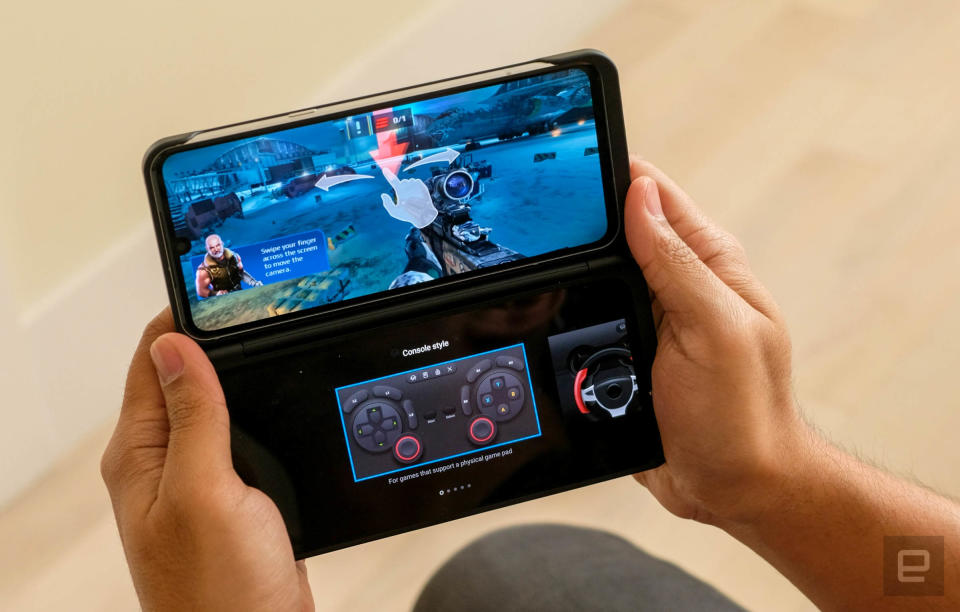
The additional screen also makes for a decent game controller provided that you launch the game on the second screen and enable the gamepad feature afterward. Otherwise, the game runs on the main display and trying to play Sniper Fury while gripping that slim second screen is basically impossible. A toggle to swap which screen the game and the controller appear on is all it would've taken to make this process painless. But, of course, there isn't one.
In fairness, the dual-screen experience is slightly less cumbersome than it was on the G8X. Still, that modicum of progress doesn't solve the underlying problem: LG's software is often more obtuse than it needs to be, which makes using both of these screens to their fullest unnecessarily complicated. At least LG fixed my biggest gripe about its dual-screen cases. Since that second screen draws power and a video signal through the phone's USB-C port, you have to use a special, magnetic adapter to charge the V60 while it's wearing the case. The one the G8X used was awful, though -- the magnet was so weak that if you so much as brushed it with your hand, it would just fall off the phone. Thankfully, the V60 ships with a magnetic power adapter that's actually worth a damn.
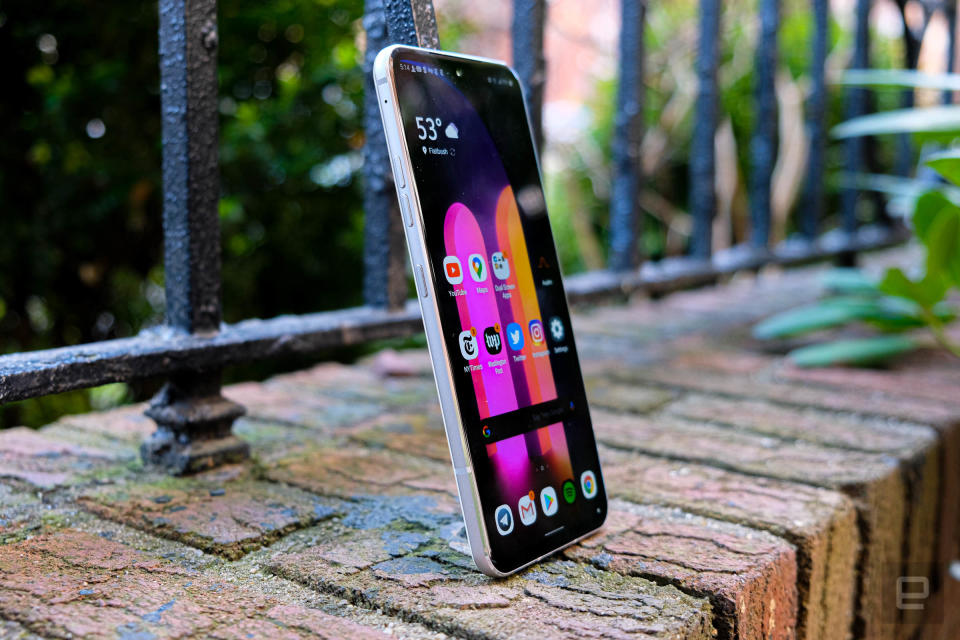
Wrap-up
Here's the really weird thing about the V60: I can't remember the last time I liked a phone that annoyed me this much. Ambitious, oddball features like 3D portraits and the dual-screen case need some serious finessing, and LG's software is in dire need of an overhaul. Ultimately though, the fact that V60 delivers on the fundamentals -- solid performance, a good-looking screen, capable cameras and long battery life -- means it's worth paying attention to. It's light on thrills, sure, but you still get a lot of phone for a reasonable price.

